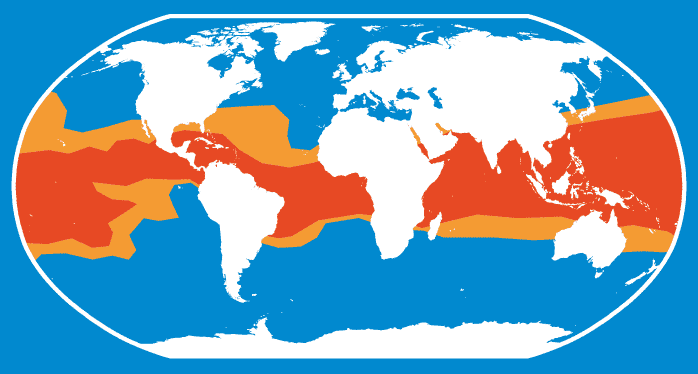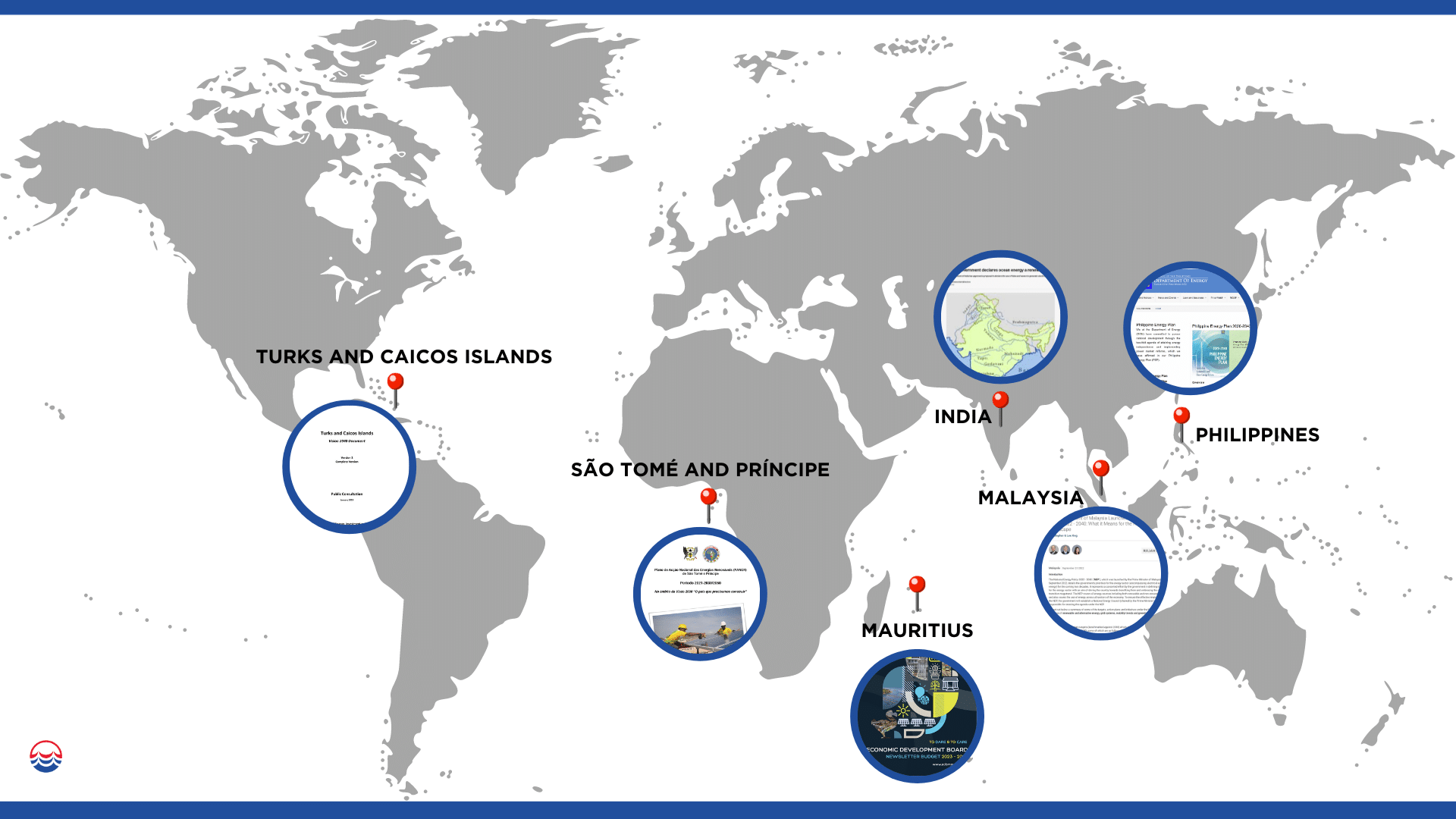23 October 2023 – The unprecedented environmental challenges our world is facing make the quest for clean and sustainable energy sources a global priority. Among the various renewable energy alternatives, Ocean Thermal Energy Conversion (OTEC) is a great solution that can help not only Small Island Developing States (SIDS), but large coastal countries, to harness the vast power of the ocean and reduce their dependence on pollutants and expensive fossil fuels. Governments worldwide are recognising the potential of OTEC and some have integrated it into their policies to achieve ambitious renewable energy targets. In this blog post, we highlight the commitment of six different governments to OTEC and its pivotal role in their renewable energy objectives.
1 – São Tomé and Príncipe
São Tomé and Príncipe, an African country in the Gulf of Guinea, has shown great interest in Ocean Thermal Energy Conversion (OTEC) and incorporated it into its “2030 Vision“. The document highlights the country’s ideal location in the tropics, which is an excellent spot for OTEC. Also, the surface seawater temperature in São Tomé and Príncipe remains at a constant 26°C throughout the year, and the cold deep water at 5°C is accessible from a depth of 800 meters. This gradient in temperature can be used to generate electricity, making it an excellent source of clean, renewable power.
Developed by Global OTEC, the first commercial-scale OTEC floating platform, Dominique, will be deployed in São Tomé and Príncipe. This platform will enable the nation to harness the power of its main natural resource, the ocean, and provide a reliable energy source for its people while generating jobs, eliminating fossil fuel dependence and reducing CO2 emissions.
2 – Mauritius
Mauritius, a small island nation located in the Indian Ocean, has been implementing significant measures to promote the use of deep ocean water and OTEC as part of its overall sustainable energy strategies. To achieve this, the country has introduced a comprehensive Green Transformation Package, which was incorporated into the 2023-2024 budget. This initiative includes extensive investments in OTEC technology, such as the construction of a 1 MW OTEC demo plant, which will provide a proof-of-concept for the viability of this technology.
The Green Transformation Package is expected to have a significant impact on the country’s economy and environment, while also accelerating the transition towards a more sustainable energy system. For instance, the adoption of OTEC technology is projected to boost the country’s GDP and create more job opportunities, particularly in the renewable energy sector. In addition, OTEC’s ability to generate clean energy from the temperature difference between warm surface water and cold deep water is expected to reduce the country’s reliance on fossil fuels, which will have a positive impact on the environment by lowering carbon emissions.
3 – Turks and Caicos Islands
The Turks and Caicos Islands (TCI) is an archipelago located in the Atlantic Ocean, consisting of 40 islands and cays. TCI is exploring OTEC to transform its energy landscape. Currently, the islands rely heavily on diesel generators, which are not only expensive but also contribute to environmental pollution. With a vision of achieving 33% renewable energy by 2040, TCI has turned to OTEC as an attractive option.
The Global OTEC team has identified TCI as an ideal candidate for OTEC due to its warm seawater with a temperature difference of approximately 20°C between surface and deep seawater, and the easy access to cold deep water. TCI’s interest in OTEC stems from its commitment to promoting sustainability and minimising its carbon footprint.
4 – India
India, with a coastline of over 7,500 kilometres, is emerging as a potential leader in the field of ocean energy. The Ministry of New and Renewable Energy (MNRE) has officially declared the use of the ocean to generate electricity as a renewable power source. The country has immense untapped potential for OTEC energy, as its vast coastline encompasses the Bay of Bengal in the east, the Arabian Sea in the west, and the Indian Ocean to the south, ideal for harnessing energy from the ocean.
The MNRE has been actively promoting the development of ocean energy in India by providing financial assistance and incentives to various stakeholders. The National Institute of Ocean Technology (NIOT) has been working on developing technologies for harnessing ocean energy, and several pilot projects have been initiated to test the feasibility of ocean energy in India.
The recognition of ocean energy sources as a potential power source is a pivotal moment in India’s quest for a sustainable future. By tapping into the vast energy potential of the ocean, India can not only meet its growing energy demands but also reduce its dependence on fossil fuels and decrease its carbon footprint. It is estimated that India’s OTEC potential is 180,000 MW.
5 – Malaysia
Malaysia has taken a significant step towards a sustainable energy future with the launch of its National Energy Policy 2022-2040 (NEP). This comprehensive policy outlines the government’s vision for the energy sector, covering both electrical and thermal energy, and encompasses all energy sources, including renewable and non-renewable options. The NEP extends its influence across all sectors of the economy, including transportation, industry, and households.
In addition, the policy shows a willingness to embrace new and innovative energy sources, such as OTEC, as part of Malaysia’s evolving renewable energy portfolio. Malaysia’s location in the tropical region with abundant warm surface waters and deep cold water makes it a great candidate for OTEC deployment.
Also, the collaboration between Universiti Teknologi Malaysia Ocean Thermal Energy Centre (UTM OTEC) and Saga University in Japan marks an exciting chapter in the pursuit of OTEC in the country. Their shared goal is to establish Malaysia’s inaugural experimental OTEC plant, a pioneering attempt that holds great promise for reducing carbon emissions and providing a clean energy solution. A hybrid demonstration plant has been constructed in Teluk Kemang and is expected to complete commissioning later this year.
Malaysia’s commitment to diversifying its energy sources puts it in a prime position to adopt OTEC as a low-carbon energy solution. The successful deployment of OTEC in Malaysia could lead to new business opportunities, job creation, and a cleaner and more sustainable energy future for the country and the world.
6 – Philippines
The Department of Energy (DOE) in the Philippines is proactively advancing its energy sector to ensure power supply security and sustainability. The DOE recognizes that relying on a single fuel source for power generation has its limitations, and it is therefore actively seeking to adopt emerging technologies for power generation, including OTEC. To this end, the DOE is creating a comprehensive policy framework that will help to guide the adoption of these new technologies. The country’s Energy Plan 2018-2040 mentions OTEC as a potential new renewable energy.
To ensure that this policy framework is developed in a collaborative manner, the DOE has been engaging in nationwide consultations and Focus Group Discussions to gather valuable insights from various stakeholders. These insights will help to inform the policy formation process, including the “Providing a Framework for Energy Storage System in the Electric Power Industry” policy.
The DOE’s dedication to advancing its energy sector demonstrates the Philippines’ commitment to utilizing emerging technologies for a more sustainable energy future. The adoption of OTEC and other emerging technologies will help to diversify the country’s energy mix, reduce its reliance on fossil fuels, and mitigate the impact of climate change.
Governments around the world have recognised the potential of OTEC and have included it in their policy framework as they strive to achieve their ambitious renewable energy targets. The commitment of six diverse governments, from the tropical paradise of São Tomé and Príncipe to India’s vast coastline, demonstrates the critical role of OTEC in shaping a sustainable and clean energy future. As these countries embark on this transformative journey, the impact of their actions extends far beyond their borders, inspiring optimism for a greener, more sustainable planet.

Where in the world OTEC is viable?
OTEC works best in tropical equatorial zones where the temperature difference is at least 20°C year-round. This means OTEC’s affordable, clean energy is perfectly placed to support Small Island Developing States (SIDs)

